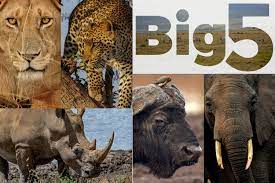Big 5 in Amboseli national park
Big 5 in Amboseli national park
African great wildlife safari experience is mostly renowned for its Africa Big 5. The word big 5 across all the African protected areas meant not the largest animals in the wilderness of Africa but the most challenging animals to the hunters. After encountering great difficulty whenever they encountered these animals anywhere in Africa, European international hunters named them. These animals were described as the most dangerous and deadly in the wilderness. Lions, leopards, buffalo, rhinos, and elephants are the African big five. Amboseli National Park is one of Kenya’s best-known national parks, as well as one of the best in the entire East African region.
The park’s enormous herds of African elephants are well-known. The park’s large wildlife population has made it one of Kenya’s most popular tourist destinations. When it comes to the Big 5, Amboseli National Park only contains four members, with the exception of rhinos, who have been extinct in the park. Before the Rhinos were slaughtered, the Big 5 in Amboseli National Park were all there. The park now contains Kenya’s biggest number of elephants. The king of the jungle, popularly known as “Simba,” is another member of the Big 5 that may be found in Amboseli national park.
Leopards and buffalos are also found in Amboseli National Park, bringing the total number of Big 5 to four (Elephants, lions, leopards and Buffalos)

The Big 5 in Amboseli National Park are listed below.
Elephants
In Amboseli National Park, elephants are one of the Big 5. They are the park’s most populous animals. The park’s fame stems from the large number of elephants that can be found there.
Amboseli National Park is home to over 1200 elephants, which is why it was designated as a UNESCO Man and Biosphere Reserve in 1991. The park is home to some of the world’s most well-known animal superstars, such as Elephant Tim, one of the most well-known elephants in the world. Thanks to the Amboseli Trust for Elephants team, which has worked to preserve and advocate for elephants in the park. Elephants make up the majority of the park’s animal population. The number of Amboseli Elephants has grown to 1600 by 2008. Natural disasters, such as extended droughts, have taken the lives of some elephants. During your game drives in Amboseli National Park, you will get the opportunity to see elephants up close. The driver guides are well-versed in their itineraries, making it simple to track where they have been at what time. Elephants in Amboseli National Park are among the most researched in the world, not only in Kenya. Echo the Unforgettable Elephant, a BBC documentary, is one of numerous worldwide documentaries based on Amboseli.
Echo was a renowned elephant in Amboseli who, at the age of 23, became the matriarch of her huge family. She was hoisted in 1973 with the use of a radio collar so that her life could be studied more easily. Her name was derived from the sound made by the radio collar, which was echoooo. Echo died in 2009, but her memories of Amboseli National Park remain vivid in the minds of many people, particularly conservationists. Amboseli’s elephants are split into 58 families, each with approximately 300 autonomous adult males. The families are governed by fully mature ladies in their late teens and early twenties. Elephants can combine together some time to make a clan, this follow the genetic relationship between them. Elephants have the longest gestation period among all animals taking 640 to 660 days. It gives to a heavy calf that can weigh up to 120 kilograms
Lions
The most admired animal to sight on an African safari is the king of the juggle. In Amboseli National Park, lions are one of the Big 5’s most important members. In Amboseli, there are around 100 lions that are frequently spotted along the road early in the morning or late in the evening. There are a handful who have the ability to climb trees, but they are extremely rare and must be discovered by accident In Amboseli National Park, lions make up the third biggest population of the Big 5. The lions in the forest are easy to spot due to the park’s modest size and wide savannah grasslands. During the park’s night wildlife drives, lions are frequently sighted. When they are hunting prey, which they like to do when it is chilly, this is when the activity is at its peak. The benefit of lions is that after their daily meal, they relax for extended periods of time in the same location, allowing tourists to watch them for a whole day at the same population.
Lions like to hunt in groups since the females are the ones that hunt the most, while the males merely watch for the kill. If they’re in the middle of a mating phase, they’ll be split in half.
Leopards
In Amboseli National Park, leopards are the most elusive and uncommon of the Big 5. They are shy, deadly animals who spend the most of their time in trees. They abandon single life unless they are mating, in which case you will be partnered with them. The driving guide must be senior in order to view the leopards, as seeing them requires an eagle eye. The leopards have spots like a cheetah but are more muscular than a cheetah, thus getting close to them is unusual unless you get it hunting. Their front legs are stronger, allowing them to lift the prey, which may weigh up to twice as much, up into the tree.
Buffaloes
In Amboseli National Park, buffaloes are the most common of the Big 5. The park is home to vast herds of buffalo that graze on the dried lakebeds of Amboseli. During the dry season, buffaloes can be spotted cooling down along lake banks and in water pools. They graze in large groups, each of which is headed by a dominant male.
Buffaloes appear to be simple creatures, yet they are quite aggressive when they charge, even if it takes a long time. Hippos, Zebras, Kudu, Wildebeests, Giraffes, Hyenas, Crocodiles, Cheetahs, Gazelles, and many more creatures may be found in Amboseli National Park. Amboseli national park is home to over 50 different types of animals, with the Big 5 being only one of them.
Due to the vast variety of creatures present in the park, your safari to Amboslei will never be disappointed. The park’s greenery encourages the animals to live there permanently.


Leave a Reply
Want to join the discussion?Feel free to contribute!